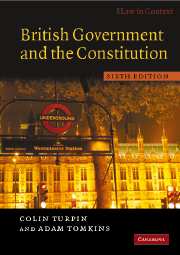Book contents
- Frontmatter
- Contents
- Preface
- Acknowledgements
- Abbreviations
- Table of Cases
- Table of Statutes
- Table of European Treaties
- Part I Constitution, state and beyond
- 1 The British constitutional order
- 2 The ideas of the constitution
- 3 Constitutional sources
- 4 Devolution and the structure of the United Kingdom
- 5 The European dimensions
- Part II Government
- Part III Accountability
- Part IV Liberty
- Index
2 - The ideas of the constitution
Published online by Cambridge University Press: 05 June 2012
- Frontmatter
- Contents
- Preface
- Acknowledgements
- Abbreviations
- Table of Cases
- Table of Statutes
- Table of European Treaties
- Part I Constitution, state and beyond
- 1 The British constitutional order
- 2 The ideas of the constitution
- 3 Constitutional sources
- 4 Devolution and the structure of the United Kingdom
- 5 The European dimensions
- Part II Government
- Part III Accountability
- Part IV Liberty
- Index
Summary
‘Successful constitutions and institutions’, says Ian Gilmour (Inside Right: A Study of Conservatism (1978), p 70), ‘are not mere pieces of machinery. If they work, it is because of the ideas and beliefs of those who try to work them.’ The British constitution, having evolved over centuries, does not embody any single constitutional theory. It is the product of a long period of kingly rule, parliamentary struggle, revolution, many concessions and compromises, a slow growth of custom, the making and breaking and alteration of many laws. Although we lack a general theory of the constitution, there has come down to us the idea of constitutionalism – of a constitutional order which acknowledges the necessary power of government while placing conditions and limits upon its exercise. The British version of constitutionalism has been shaped by a number of leading ideas or principles: some of these have crystallised as rules or doctrines of the constitution; others have influenced constitutional thought or have gained currency as explanations or justifications of particular features of the constitution. In this chapter we shall consider some of these commanding ideas or doctrines and their place in the modern constitution. We start with democracy and then move on to consider the sovereignty of Parliament, the rule of law, the separation of powers and accountability. It will appear that, at times, there is a conflict, or tension, between these ideas; between democracy, for instance, and parliamentary sovereignty, or between sovereignty and the rule of law.
- Type
- Chapter
- Information
- British Government and the ConstitutionText and Materials, pp. 33 - 137Publisher: Cambridge University PressPrint publication year: 2007



